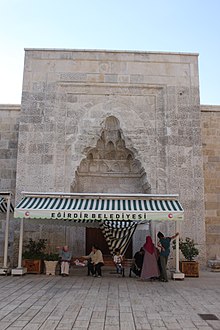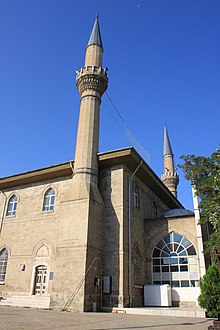Hamidoğulları
The Hamidoğulları , also Hamididen or Hamed dynasty ( Turkish also Hamitoğulları ) were an Anatolian Beylik (principality).
area
During the collapse of the Rum Seljuk Empire, Hamid Bey formed a small army out of wandering Turkmens called the Hamid Turkmen . They occupied the area around Uluborlu , which he made his capital. His grandson Feleküddin Dündar conquered Eğirdir and made it the capital of his beylik. The city was now called Felekâbât. The Beylik comprised about today's counties Eğirdir, senirkent , Atabey , Isparta , Gönen , Uluborlu, Keçiborlu and Şarkikaraağaç in today's province of Isparta , and the districts Ağlasun , Çeltikçi , Burdur and Kemer in the present province of Burdur and Şuhut , Dinar , Çay and Sultandağı in Afyonkarahisar Province . Hızır Bey conquered the cities of Beyşehir , Seydişehir and Akşehir ; thereafter the Beylik remained more or less unchanged, even after the collapse of the rule of the Rum Seljuks. Like his son İlyas Bey, he also ruled Antalya. İlyas Bey divided up his kingdom: his successor was his eldest son, Feleküddin Dündar. Yunus, the second born, stayed in Antalya and founded the beylik of the Tekeoğulları there . Dündar built up a large army with 15,000 soldiers and 15,000 riders. He also had 15 castles built. Relying on this strength, he refused to submit to the Mongol Ilkhan Abū Saʿīd Bahador Chan. In 1316 he claimed the title of sultan. In 1317/18 Dündar was attacked and defeated by Timurtaş (Turkish: Demirtaş ), the grandson of the great Ilkhan of Persia, Abū Saʿīd Bahador Chan. Dündar was executed after the defeat in 1324; his sons were able to flee to the Mamluks in Egypt. However, Timurtaş had rebelled against his grandfather in 1322 and was forced to flee to Egypt by him in 1327 and murdered there in 1328. In the same year (1327), Khidhr (Turkish: Hızır ) Bey, Dündar's eldest son, came back home and restored the Beylik Hamidoğulları. Khidhr Bey also conquered the provinces of Beyşehir , Seydişehir and Akşehir .
After his sudden death, his brother Najm al-Dîn Abû Ishâq (Turkish: Necmeddin İshak Bey ) returned from Egypt and ruled until 1340 or 1344. His successor was Muzaffar al-Dîn Mustafâ (Turkish: Muzaffereddin Mustafa Bey ), his brother's son Mehmed, who ruled until 1355 or 1357. His son Husâm al-Dîn Ilyâs (Turkish: Hüsameddin İlyas Bey ) succeeded him and ruled until 1370 or 1374. During his reign there was a constant battle with the Beylik Karaman , who expanded his territory at the expense of the Hamidoğulları. After a defeat he had to flee to Suleyman Bey in Germiyan , but was able to recapture his principality with his help.
His son Kamâl al-Dîn Husayn (Turkish: Kemâleddin Hüseyin Bey ) succeeded him in 1370 or 1374. He was still exposed to the pressure of the Karamanids and sought support from the main opponent of Karaman, the Ottomans . In 1374 or 1381 he sold his principality for 80,000 gold pieces to Sultan Murad I. In 1389 Kemâleddin Hüseyin Bey took part in the battle on the Blackbird Field on the side of the Ottomans. With his death in 1390 or 1391 the Beylik fell to the Ottomans, who incorporated it into the Beylerbey Anatolia as Sandschak Hamid . Karaman took the opportunity to occupy cities in the east of the Beylik, including Beyşehir , Seydişehir and Akşehir . This became the cause of increasing tensions between the Ottomans and the Karamanids.
dynasty
| year | Surname | Turk. Surname | son of | |
|---|---|---|---|---|
| ? - 1280 | Hamid Bey | Ruler in Antalya. | ||
| 1280 - 1300/01 | Ilyâs | Hamidoğlu İlyas Bey | Hamid Bey | Ruler in Antalya. |
| 1300/01 - 1324 | Falak al-Dîn Dûndâr | Feleküddin Dündar | Ilyâs or Teke | First bey from Hamid. |
| 1324- 1327 | Conquest under Timurtaş, a son of Abū Saʿīd. | |||
| 1327 1328 | Khidhr | Hızır | Dündar | |
| 1328- ~ 1340 or 1344 | Najm al-Dîn Abû Ishâq | Necmeddin Ishak | Dündar | |
| ~ 1340 or 1344- ~ 1355/57 | Muzaffar al-Dîn Mustafâ | Muzafferüddin Mustafa | Mehmed Çelebi, grandson of Dündar | |
| ~ 1355 / 57- ~ 1370 or 1374 | Husâm al-Dîn Ilyas | Hüsameddin Elyas | Mustafa | |
| ~ 1370 or 1374- 1391 | Kamâl al-Dîn Husayn | Kemaleddin Huseyin | Elyas | Sales of Beyliks to Sultan Murad I . |
| 1391 | Connection to the Ottoman Empire . | |||
Cultural heritage
Only a few buildings have survived from the Hamidid period. A selection:
- Eğirdir: Feleküddin Dündar had the "Taş Medrese" (also: Dündar Bey Madrasa) built in Eğirdir in 1301 from the stones of the former Eğirdir-Hans . It is the historically most valuable building from the Hamidoğulları era.
- Uluborlu: The "Muhittin Fountain" and the "Arapçık Fountain" in Uluborlu. They were built by Feleküddin Dündar between 1300 and 1324, as was the "Efendi Sultan Mosque".
- Isparta: "Hızır Bey Mosque"; it was built by Hızır Bey together with the "Hızır Bey Haman" in 1327/28 under Hızır Bey, which is now a ruin. The mosque was destroyed in the great earthquake in Isparta in 1888 and rebuilt after the quake.
- Şuhut: the "Kubbeli mosque with minaret", built between 1328 and 1355.
- Burdur: The Ulu Camii from 1300; destroyed by earthquake in 1914, rebuilt until 1930, as well as the "Muzaffereddin Madrasa", built between 1340 and 1355 under Muzaffereddin Mustafa Bey.
swell
- Kofoğlu, Sait: Hamidoğulları in TDV IA
- de Planhol, Xavier: Ḥamīd, or Ḥamīd Og̲h̲ullari̊ in EI2
- Bosworth, Clifford Edmund: The New Islamic Dynasties , Edinburgh University Press 1996, p. 226
- İsmail Hakkı Uzunçarşılı: Anadolu Beylikleri ve Akkoyunlu, Karakoyunlu Devletleri, Türk Tarih Kurumu ( Anatolian Principalities and Akkoyunlu, Karakoyunlu States; Turkish Historical Society ) pp. 62–69; Ankara 1937, ISBN 975-16-0044-8
Individual evidence
- ↑ EJ Brill's First Encyclopaedia of Islam 1913-1936; New edition by Martijn Theodoor Houtsma; Pp. 720-721; Verlag Brill, 1987
- ^ Clifford Edmund Bosworth: The new Islamic Dynasties. The Hamid Oghullarî and the Tekke Oghullarî; P. 226; Edinburgh University Press; 2004
- ↑ Ibn Battûta: Voyages II. De La Mecque aux steppes russes et à l'Inde; Collection FM / La Découverte Librairie François Maspero, p. 118, Paris, 1982
- ↑ René Grousset: Règne d'Aboû Sa'îd; Pp. 487–488 (.pdf)
- ↑ EJ Brill's First Encyclopaedia of Islam 1913-1936; New edition by Martijn Theodoor Houtsma; Pp. 250-251; Brill publishing house, 1987
- ^ After The new Islamic Dynasties. The Hamid Oghullarî and the Tekke Oghullarî; P. 226ff; Edinburgh University Press; 2004


